Best Custom Mobile App Development Guide for 2023
In 2022, there were 789,600 apps developed in Asia, about 705,600 apps in North America, and 549,600 apps in Europe (minus the UK). With the quick development in the app development, soon came the mobile app development. Because the better you cater to a person’s specific needs, the audience will be more loyal.
Year 2023 will be the year for apps that will follow some trends to cater the need of the industry.
Let us nose dive into a custom app development guide for 2023.
What is Custom Mobile App Development?
Custom mobile app development involves crafting a mobile application to fulfill the specific requirements of a business or organization. In contrast to ready-made apps intended for a broad user audience, custom apps are built with particular needs in mind, incorporating distinctive features, user interfaces, workflows, and data integrations.
The process of custom mobile app development typically involves several stages, including:
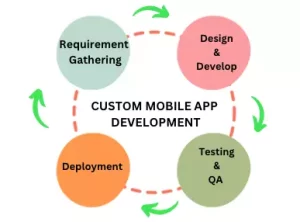
-
-
Requirements Collection:
Commence by pinpointing the business needs and user requirements for the app.
-
Design and Implementation:
Once the requirements are identified, the app design and development team devises a comprehensive plan outlining the features, user interface, and functionality. Subsequently, the development team constructs the app according to the developed plan.
-
Testing and Quality Assurance:
Following the app’s development, it undergoes rigorous testing and quality assurance procedures to guarantee its proper functioning, reliability, and alignment with user needs.
-
Deployment:
Once the app successfully passes testing and approves, it is deployed to the app store or enterprise distribution platform.
Tailoring mobile apps to specific business requirements brings numerous advantages to companies, enhancing their ability to craft a distinct app tailored precisely to their needs. This approach contributes to a superior user experience, heightened productivity, and increased efficiency. Additionally, it furnishes a competitive edge by presenting customers or employees with a more personalized and unique app encounter. Nevertheless, opting for custom app development demands substantial time and resources. Hence, it is crucial to thoroughly assess business needs, carefully weigh costs and benefits, and make informed decisions before embarking on a custom app development journey. -
Why & When Do You Need a Custom Mobile App?
A custom mobile app may be necessary for a business or organization when the available off-the-shelf apps do not meet their specific requirements or business needs. Here are some common reasons why you may need a custom mobile app:
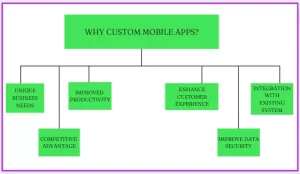
- Unique business needs:
Should your business possess unique needs that cannot be fulfilled by ready-made applications, adopting a custom mobile app might be imperative to deliver the required functionality.
- Competitive advantage:
A custom mobile app can differentiate your business from competitors by providing a more personalized and unique customer experience.
- Improved productivity:
A custom mobile app can be designed to streamline business workflows and processes, leading to improved productivity and efficiency.
- Enhanced customer experience:
Tailoring a mobile app to align with your customers’ requirements allows for a more personalized and captivating experience, ultimately enhancing customer satisfaction and loyalty.
- Improved data security:
Custom mobile apps can be designed with enhanced security features to protect sensitive business data and prevent unauthorized access.
- Integration with existing systems:
Custom mobile apps can be designed to integrate with existing enterprise systems and databases, providing employees a seamless and integrated experience.
Next let us read why a mobile app fail?
Also Read : Step by Step Guide to Develop an Android App
Why Mobile Apps Fail?
Mobile apps fail for various reasons. Here are some of the most common reasons why mobile apps fail:
Poor user experience:
If an app is challenging to use, has confusing navigation, or needs features users to expect, it will likely be uninstalled.Two examples of brand mobile apps that failed due to poor user experience:
- “Clinkle” –

Clinkle was a mobile payment app launched in 2013 with the promise of revolutionizing how people make payments. The app was backed by high-profile investors and garnered significant media attention.
However, the app’s user experience was widely criticized, with users reporting that it was confusing and confusing. Clinkle failed to gain traction and eventually shut down in 2016.
- “Yik Yak” –
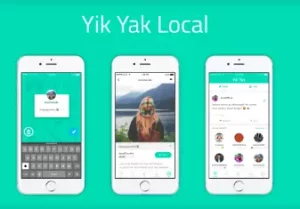 Yik Yak, a social networking app based on location, permitted users to share anonymous messages within a 1.5-mile radius. While it gained popularity among college students, it faced criticism for fostering cyberbullying and hate speech. The app’s user experience needed more transparency and ease of navigation. Addressing these issues might have been crucial, but Yik Yak ultimately closed down in 2017
Yik Yak, a social networking app based on location, permitted users to share anonymous messages within a 1.5-mile radius. While it gained popularity among college students, it faced criticism for fostering cyberbullying and hate speech. The app’s user experience needed more transparency and ease of navigation. Addressing these issues might have been crucial, but Yik Yak ultimately closed down in 2017
Technical issues:
If an app crashes frequently, has slow performance, or has bugs and glitches, users will likely abandon the app and leave negative reviews. Indian brand apps that faced technical issues, leading to their failure:
- “Aadhaar” –

Aadhaar is a digital identification system that is mandatory for all Indian citizens. The Aadhaar app was launched to provide users with easy access to their Aadhaar card details. Still, the app faced several technical issues that made it difficult for users to access their information. Additionally, there were concerns about data privacy and security, which further impacted the app’s adoption.
- “Hike” –

Hike was a messaging app launched in 2012 and gained popularity due to its unique features, such as regional stickers and local language support. However, the app faced several technical issues, including frequent crashes and slow performance. The app’s user interface was criticized for needing to be clearer and easier to navigate. These issues ultimately led to a decline in user engagement, and the app was shut down in 2021.
Lack of value:
An app needs to provide more value to the user or solve a problem for the user, or else they will not use the app. Two examples of Indian apps that failed due to lack of value:
- “Sarahah”

Sarahah was a messaging app launched in 2016 to allow users to provide anonymous feedback to their friends and coworkers. The app gained popularity due to its unique concept but faced criticism for enabling cyberbullying and harassment.
Many users found that the app provided little value beyond its initial novelty, which led to a decline in user engagement. The app was eventually shut down in 2018.
- “Hopper” –

Hopper was a location-based check-in app launched in 2012. The app aimed to provide users with personalized recommendations for nearby places to visit, but it faced criticism for not providing significant value beyond its essential features.
The app faced several technical issues, such as slow performance and frequent crashes, which further impacted its adoption. Hoppr was eventually shut down in 2016.
Inadequate marketing:
An app must be marketed effectively to gain enough traction to succeed. Effective marketing strategies include app store optimization, social media advertising, and influencer marketing.
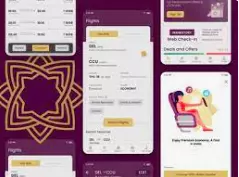
An instance of an Indian brand app encountering failure due to insufficient marketing efforts is “Vistara,” a mobile application launched by an Indian airline company.
Vistara aimed to deliver users a seamless booking and travel experience, incorporating real-time flight status updates, online check-in, and in-flight entertainment.
However, Vistara encountered intense competition from established players in the Indian airline industry, such as Jet Airways and IndiGo. Despite having a loyal customer base, the company needed to allocate more resources to marketing and advertising the app to reach a wider audience.
Consequently, many potential users needed to be made aware of the app’s features and benefits, impeding its adoption and leading to its eventual decline. This case underscores the significance of effective marketing and promotion for the success of a mobile app, especially in a saturated and competitive market.
Therefore, developers must ensure that their app is adequately promoted to reach its target audience and generate enough user adoption to ensure its success.
Poor customer support:

App customer support can result in users needing help finding assistance when encountering problems, leading to frustration and discontent.
A notable example of an Indian brand app that experienced failure due to inadequate customer support is “Ola Cafe,” a food delivery app launched by Ola, a renowned ride-hailing company in India. Ola Cafe aspired to offer users a user-friendly platform for ordering food from local restaurants and cafes.
The app encountered various technical issues, such as frequent crashes and slow performance, negatively impacting the user experience.
Furthermore, numerous users reported unsatisfactory customer support experiences, including delays in order fulfillment and challenges obtaining refunds for canceled orders.
These issues contributed to decreased user engagement and adoption, with many users opting for competing food delivery apps that provided superior customer support and a better overall user experience.
Lack of updates:
An app must be updated regularly to maintain its relevance, leading to a decline in user engagement and eventual abandonment.

One example of an Indian app that failed due to a lack of updates is “Hike Messenger,” a popular messaging app launched in 2012. Hike aimed to provide users with a unique messaging experience by incorporating localized features such as regional stickers and language-based keyboard layouts.
However, Hike faced stiff competition from established players in the messaging industry, such as WhatsApp and Facebook Messenger. Hike initially gained popularity due to its unique features and localisation.
The company could have innovated to improve the app in response to changing user needs. The company should have released timely updates to the app for higher engagement.
Competition:
The app marketplace is highly competitive, and if many other similar apps are available, it can be challenging to attract and retain users.
An Indian app brand that failed due to competition is “FreeCharge,” a mobile payments and digital wallet app launched in 2010. FreeCharge aimed to provide users with a convenient and secure platform for making mobile payments and recharging their mobile phones and utility bills.
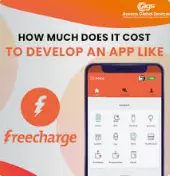
While FreeCharge initially gained popularity due to its simple and intuitive user interface and attractive cashback offers, the company needed to innovate and expand its services in response to changing user needs and preferences. The company faced financial challenges and was eventually acquired by a competitor in 2017, which led to its eventual decline.
This example highlights the importance of remaining competitive in the mobile app market.
Developers must ensure that their app offers users unique value and can differentiate itself from established players in a crowded market.
How To Choose The Right Tech Partner For Custom Mobile App Development?
Choosing the right tech partner for custom mobile app development can be a critical decision that can significantly impact the success of your project.
Here are some key factors to consider when selecting a tech partner for your custom mobile app development:
Technical expertise:
Choosing a partner with strong technical knowledge in mobile app development is essential. You should evaluate the potential partner’s portfolio, experience, and the technologies they use to ensure they have the necessary skills to deliver a high-quality app.
Communication and collaboration:
Communication is key when working with a tech partner. You should look for a transparent, open, and responsive partner in their communication. Additionally, you should ensure that your potential partner can work collaboratively with your team and that they are willing to listen and understand your needs.
Quality assurance and testing:
Quality assurance and testing are critical aspects of app development. You should choose a partner with a robust testing process to ensure the app is reliable and performs well.
Support and maintenance:
The app development process does not end with the launch of the app. You should choose a partner who can provide ongoing support and care to ensure that the app remains up-to-date and bug-free.
Cost and budget:
Cost is essential when choosing a tech partner.
How to Choose Mobile App Development Platforms & Tech Stack?
Selecting the appropriate mobile app development platform and tech stack is pivotal for the success of your application.
Here are vital considerations when choosing the right platform and tech stack for your mobile app development project:
Platform and Device Support:
Select a platform that caters to the devices of your intended audience, covering both iOS and Android operating systems, diverse device sizes, and screen resolutions. Assess the platform’s features, APIs, and SDKs to guarantee the actualization of your envisioned functionality and user experience.
App Type:
The category of app you are developing—native, hybrid, or web—will influence your decision regarding the platform and tech stack. Native apps utilize platform-specific technologies like Swift for iOS and Kotlin for Android, while hybrid apps use web technologies such as HTML, CSS, and JavaScript.
Development Team Skills:
Consider the proficiency and expertise of your development team, as this will influence your choice of platform and tech stack. If your team is adept in a particular language or framework, leveraging those tools may offer a more cost-effective approach to app development.
Scalability:
Anticipate the future needs and growth of your app. Opt for a platform and tech stack capable of scaling to accommodate the expansion of your app and its user base.
Development Time and Cost:
Factor in the time and cost required for development. Evaluate and compare the development time and cost associated with different platforms and tech stacks to identify your project’s most efficient and cost-effective option.
Community Support:
Finally, take into account the assistance available from the platform developer community. Look for vibrant online communities, forums, and thorough documentation that can aid in resolving issues and support learning from the insights and experiences of fellow developers.
Advantages of Custom Mobile App Development
Custom mobile app development provides numerous advantages compared to pre-built apps or off-the-shelf solutions. Here are some key benefits of bespoke mobile app development:
Tailored to Your Business Needs: Custom mobile apps are crafted to meet the specific requirements of your business. This ensures that you have a solution customized to your unique needs, enhancing efficiency and productivity.
Better User Experience: Custom mobile apps prioritize the end-user experience, offering an intuitive and user-friendly interface. This can enhance user engagement and satisfaction, resulting in increased adoption and usage of the app.
Increased Security: Custom mobile apps can incorporate robust security features, safeguarding your business data and sensitive information from cyber threats. This helps mitigate the risk of data breaches and other security incidents.
Scalability: Custom mobile apps can be designed to scale alongside your business, allowing for the addition of new features and functionalities as your business expands and evolves.
Integration: Custom mobile apps can seamlessly integrate with other systems and applications, such as CRMs, ERPs, and other business tools. This enhances workflow and increases overall productivity.
Competitive Advantage: A custom mobile app offers an edge over businesses utilizing off-the-shelf solutions or generic apps. This differentiation can enhance your brand reputation and set your business apart.
Custom Mobile App Development Cost
The average cost of mobile app development can be around $60,000 to $100,000 for one platform. The cost may rise to $150,000 for hybrid development.
Conclusion
Creating a custom mobile app requires meticulous planning, effective communication, and technical proficiency. Critical considerations include choosing a tech partner, platform, and tech stack, emphasizing technical expertise, communication, quality assurance, support, budget, device support, app type, team skills, scalability, development time, cost, and community support. Businesses and individuals can develop tailored, high-quality mobile apps for a positive user experience by prioritizing these factors and collaborating with a reliable partner. For custom mobile app development inquiries, contact us at hello[at]noboruworld. com.
FAQ’s
Is custom app development worth it?
Whether custom app development is worth it depends on the specific needs and goals of the business or individual. However, in many cases, custom app development can provide significant benefits over pre-built, off-the-shelf solutions, such as:
- Tailored functionality: A custom app can be designed to meet the specific needs and requirements of the business or individual. This can lead to increased efficiency, improved user experience, and enhanced productivity.
- Competitive advantage: A custom app can give a business a competitive edge by offering unique features and functionality unavailable in pre-built solutions.
- Brand recognition: A custom app can be designed to reflect a business’s branding and image, which can help to increase brand recognition and awareness.
- Data security: With a custom app, a business or individual can ensure that their data is stored and handled securely.
- Long-term cost savings: While custom app development can be more expensive upfront, it can lead to long-term cost savings by eliminating the need for multiple off-the-shelf solutions or integrations.
How much does it cost to build a custom mobile app?
The cost of building a custom mobile app can vary widely depending on a range of factors, such as the complexity of the app, the platform(s) it will run on, the development team’s location and experience, the number of features and functionalities, and the design and user interface requirements.
Based on industry estimates, the cost of building a custom mobile app can range anywhere from $10,000 to $500,000 or more, depending on these factors.
For example, a simple mobile app with limited features and functionality might cost between $10,000 and $50,000, while a more complex app with advanced features and high-end design might cost over $100,000 or more.
It’s important to note that the cost of building a custom mobile app continues after the initial development process. In addition, ongoing maintenance, updates, and support can add to the overall cost of the app.
Ultimately, the cost of building a custom mobile app will depend on the specific needs and requirements of the project. Therefore, businesses or individuals looking to develop a custom mobile app should work with a trusted development partner to get a more accurate estimate of the total cost.
Can I develop my own mobile app?
You can develop your own mobile app with the necessary technical skills and resources. Various mobile app development tools and platforms are available that can make it easier for non-technical individuals to develop a mobile app.
However, keep in mind that mobile app development is a complex and time-consuming process that requires expertise in various areas, including programming languages, user interface design, database management, and more.
If you need the necessary technical skills, you can hire a mobile app development company or freelancer to help you develop your app.
Reference-
https://doit.software/blog/mobile-app-development
https://topflightapps.com/ideas/custom-mobile-app-development-guide/
https://www.invonto.com/insights/mobile-app-development-process/
https://www.openxcell.com/mobile-app-development/



